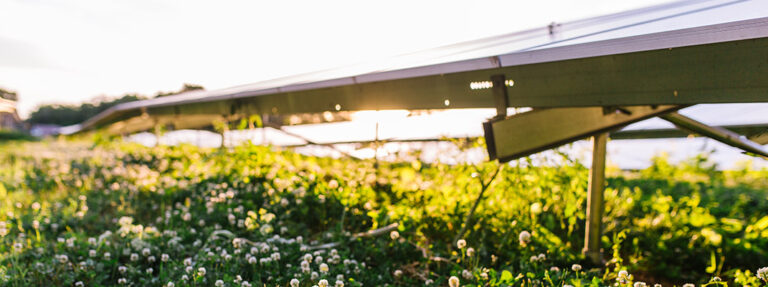Solar farms are spreading fast across the United States, but what’s happening underneath the panels is just as important as the energy they produce. As millions of acres are converted to solar use, developers and landowners face a critical question: What should we plant on all that land?
The answer could shape not just your maintenance budget, but the health of local ecosystems for decades to come.
In this blog, you’ll learn:
- Why native vegetation is more cost-effective than turf or gravel
- How deep-rooted natives improve drainage and soil health
- The role solar farms can play in pollinator recovery
- Which native vegetation is ideal for solar installations
Let’s begin by looking at just how much land is at stake.
The Scale of the Opportunity
While the energy sector gets most of the attention when it comes to the development of solar energy, there’s a second-order consequence that’s going unnoticed: the rise of solar farms will reshape the very landscape under our feet. That’s because, if current trends continue, the U.S. will need to devote approximately 10 million acres of land to solar farms by 2050 to meet its climate goals. That’s bigger than the state of Maryland.
Ultimately, what we choose to plant on that land will have an immense impact.
Why Turf and Gravel Fall Short
The default vegetation strategy for many solar farms is either turfgrass, gravel, or bare soil, but they introduce a range of avoidable issues:
- Poor soil health and erosion risk
- Increased maintenance costs (especially mowing)
- Little to no ecological value
- Vulnerability to runoff and drainage problems
Despite their obvious drawbacks, turf and gravel certainly seem like a quick fix. However, the degradation of the natural environment will make them unsustainable in the long term. If you’re a landowner, developer, or policymaker, the implications are clear: solar vegetation management is no longer a side issue; it’s central to long-term site performance and sustainability.
Cost Factors: Native Vegetation vs. Turf By the Numbers
When it comes to vegetation choices under and around solar panels, the economic case for native plants is hard to ignore.
Installation Costs of Turf vs. Native Vegetation
According to the U.S. Environmental Protection Agency, turf grass can cost anywhere from $4,000 to $8,000 per acre to install. In contrast, native grasses and forbs generally cost between $2,000 and $4,000 per acre to seed.
And the savings don’t end there.
Why Maintenance Costs Matter Even More
The bulk of long-term expenses on any solar site comes from ongoing maintenance. Turf demands:
- Regular mowing
- Irrigation in dry periods
- Fertilization and weed control
- Labor and fuel for equipment
Native vegetation, once established, requires none of that. Deep-rooted plants are self-sustaining, suppress invasive weeds, and tolerate drought conditions naturally. Over a 10-year span, maintenance savings can be substantial.
What You Can Do
If you’re building or managing a solar site, don’t just look at upfront costs. Run a multi-year cost comparison between traditional turf and native vegetation.
Here’s how to start:
- Model O&M budgets for at least 5 years
- Consult with a native seed provider (like Ernst) to understand establishment timelines
- Factor in savings from reduced mowing, irrigation, and inputs
The bottom line is this: native vegetation will always be the most ecologically-friendly choice. The good news is that’s usually the more economical one, too.
Why Native Vegetation is Better for the Land: Drainage, Soil, and Water Retention
One of the main long-term challenges for solar farms is managing stormwater, especially those built on former agricultural land or compacted soils. While turf or gravel offers little benefit, native vegetation offers a low-maintenance solution that improves site performance over time.
A study from the U.S. Geological Survey compared rain gardens planted with native prairie species to those with turf grass. The results were clear: native plantings had significantly higher median infiltration rates, regardless of soil type. That means less standing water, reduced erosion risk, and improved stormwater management.
Why Native Roots Make the Difference
The effectiveness of native vegetation comes down to root systems:
- Turf grass roots: typically shallow (1–2 inches), offering limited infiltration
- Native grass and forb roots: can reach several feet deep, creating channels for water to percolate into the soil
These deeper roots also improve soil structure and organic content over time, which is critical for both site stability and long-term vegetation health.
Putting Knowledge into Practice
If the combination of ecological and economic benefits has you convinced, here are a few steps you can take immediately to start making a difference:
- Prioritize native species with deep, fibrous root systems(more on this below)
- Avoid compacted gravel in non-essential areas
- Seed wherever possible
- Work with a seed vendor who understands your region’s soil profile
By investing in the right vegetation early on, you can solve drainage issues before they become costly.
Rebuilding Habitats: How Solar Farms Can Help Save the Bees
With millions of acres projected for development, every site presents an opportunity to restore pollinator habitat at a meaningful scale.
Consider this: A multi-year study by Argonne National Laboratory and the National Renewable Energy Laboratory found that solar farms planted with native vegetation saw a threefold increase in total insect populations and a twentyfold increase in native bee populations over five years. That kind of impact doesn’t require pristine wilderness, just smart planning and a will to make a difference.
The Pollinator Payoff
The simple fact is that native vegetation supports local pollinators in ways that turf or gravel can’t. The right seed mix can:
- Provide nectar and pollen across the growing season
- Offer nesting and overwintering habitat
- Support food webs that sustain birds and other wildlife
This is particularly valuable in agricultural regions, where nearby crops often depend on healthy pollinator populations for yield and quality.
Getting Started: What Native Vegetation to Plant on Your Solar Site
A well-planned seed mix will establish quickly, suppress weeds, support pollinators, and require minimal maintenance after the first few years. Here are five native species commonly recommended for solar installations in the Northeastern U.S.:
- Little Bluestem (Schizachyrium scoparium) – A drought-tolerant bunchgrass with strong root systems that stabilize soil and provide year-round structure.
- Canada Wildrye (Elymus canadensis) – A cool-season grass that establishes rapidly and provides early-season cover while slower species take hold.
- Lanceleaf Coreopsis (Coreopsis lanceolata) – A cheerful, early-blooming wildflower that attracts bees and adds visual appeal to your planting.
- Wild Bergamot (Monarda fistulosa) – A fragrant, late-summer bloomer that supports native bees, butterflies, and other beneficial insects.
- Butterfly Milkweed (Asclepias tuberosa) – A vibrant orange flower and critical host plant for monarch caterpillars.
These species can be purchased individually or as part of a custom seed mix from Ernst, tailored to your site’s soil type, sunlight conditions, and ecological goals.
Partnering with Ernst for Smarter Solar Landscapes
As solar energy expands across the country, the land beneath and around each array represents a valuable opportunity. We’ve explored how native vegetation can reduce costs, improve soil and water performance, and support pollinators.
If you’re planning or managing a solar installation, Ernst Conservation Seeds offers the technical expertise and high-quality seed mixes you need to turn your site into a sustainable, resilient landscape.
Whether you’re looking for individual species or a tailored mix, Ernst can help you get the most from every acre. Contact our experts today or browse our seed finder to find the right seed mix for your landscape.

